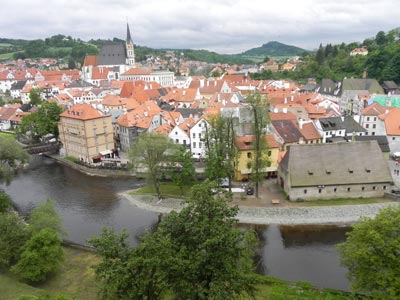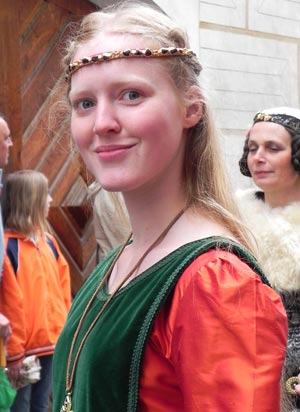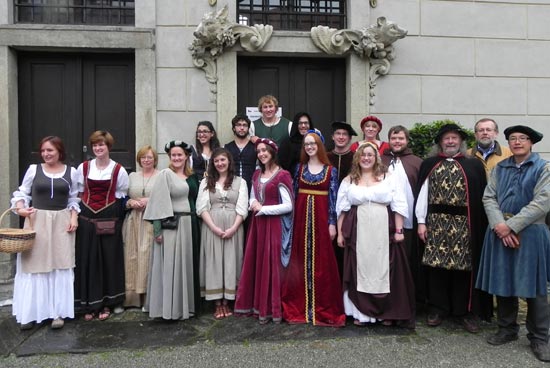 |
| The view from the classroom window. (Marilyn Smulders Photo) |
It’s a good thing the desks in our classroom faced away from the windows: the view was too diverting.
Let me explain. I took a Dalhousie summer class, Advanced Seminar in Baroque Culture (HIST 4162/ THEA 4735/ MUSC 4360), in a castle in the Czech Republic. ?eský Krumlov Castle to be exact, a large rambling complex with Gothic, Renaissance and Baroque elements perched on tall rock cliffs overlooking the Vltava River. Since 1302, the castle has been home to three aristocratic families.
From the window, you can see terracotta roofs of houses wrapped cheek-by-jowl around a horseshoe bend of the Vltava, a fast-running river cutting across this beautiful eastern European country. As the weather got warmer, rafters rode the current of the Vltava through ?eský Krumlov. Like the old town of Lunenburg in Nova Scotia, it’s designated a UNESCO World Heritage Site. But it’s much, much older: the statues of saints in the town square, for example, were erected in appreciation of the town being spared the brunt of a plague in the 1600s.
With the windows open, Dalhousie’s troupe of theatre, history and music students could hear the hoots and hollers of rafters over our professors – humanities professor Simon Kow, who lectured on European history and philosophy; and music professor Adrian Hoffman, who introduced us to opera, the predominant musical form of the Baroque era. It’s a credit to them that they could hold our attention.
But there is really no better way to learn history than to be immersed in it. Even studying for exams and writing essays wasn’t so bad when you could take a break by indulging in "trdelnik," a sweet, rolled dough pastry served piping hot from a bakery window, or by speculating whether to order schnitzel or goulash for dinner that night. (Living in ?eský Krumlov, where beer costs about 40 cents, is easy on the student budget.)
 |
| Townsfolk get dressed in Renaissance finery for the Five Petalled Rose Festival. (Marilyn Smulders Photo) |
For theatre students, of particular interest was ?the Castle Theatre, a gem of a Baroque theatre dating to 1766. Watching an opera there enabled us to relive the theatre-going experience of the Bohemian aristocracy. The original theatre has been preserved as well as the three-dimensional sets, stage machinery, props, costumes and ornate decorations.
Our host in ?eský Krumlov was Peter Perina, a suave, ascot-wearing Dalhousie professor who recently retired after a 35-plus-year career. Since first working as a scenography student at the castle in the 1960s, he’s maintained a strong connection with ?eský Krumlov Castle. He now serves as the chair of the Baroque Theatre Foundation, founded in 1992 to protect and revitalize the theatre.
As he came to collect us from the classroom to show us yet another aspect of the castle "we really must see," he carried a ring heavy with intriguing skeleton keys. With those keys, he could take us anywhere: up the tower for a dazzling view of the town and the rolling green countryside beyond; into the portrait gallery of the castle where generations of Rosenbergs, Eggenbergs and Schwartzenbergs met our gaze from their ornate frames; and through a secret door in a stone wall to watch fireworks at midnight.
It seemed like the entire town was in on our course. During the Five Petalled Rose Festival, hundreds of townsfolk got dressed up in Renaissance finery and paraded through the narrow cobblestone streets. We watched knights in armour jousting, folk dancing in the town square and a chess game played with real people on a board 12 metres by 12 metres square. We loved to roam the market where you could buy historic replicas of weapons, test your skill with a crossbow or snack on hunks of cheese. The town was packed with tourists that weekend, but even so, if felt like it was just for us.
We too donned costumes for the festivities, but weren’t nearly as grand. Although there were a few lords and ladies among us, most of us were peasants – the men in puffy shirts, doublets and breeches, the women in chemises, tightly laced bodices and wide skirts.
Somehow, time travel feels more authentic when you’re attired in scratchy wool and unbleached linen.
Interested in learning more?
|
Comments
comments powered by Disqus

